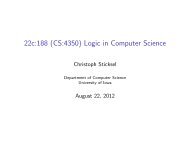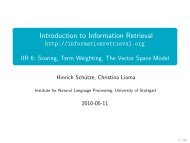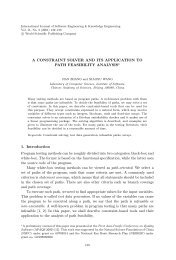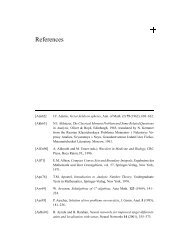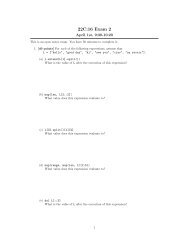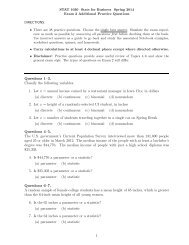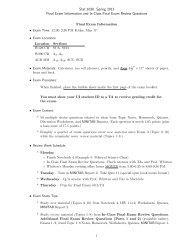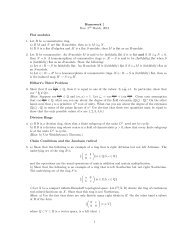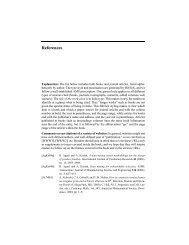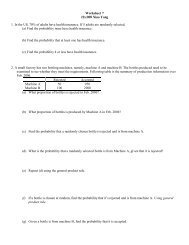Interactive Refractions with Total Internal ... - University of Iowa
Interactive Refractions with Total Internal ... - University of Iowa
Interactive Refractions with Total Internal ... - University of Iowa
You also want an ePaper? Increase the reach of your titles
YUMPU automatically turns print PDFs into web optimized ePapers that Google loves.
ABSTRACT<br />
<strong>Interactive</strong> <strong>Refractions</strong> <strong>with</strong> <strong>Total</strong> <strong>Internal</strong> Reflection<br />
Scott T Davis ∗<br />
<strong>University</strong> <strong>of</strong> <strong>Iowa</strong><br />
Chris Wyman †<br />
<strong>University</strong> <strong>of</strong> <strong>Iowa</strong><br />
(a) (b) (c)<br />
Figure 1: Comparison <strong>with</strong> (a) our approach <strong>with</strong> 3 internal bounces, (b) image-space refraction [20] and (c) ray tracing <strong>with</strong> 8 samples per pixel.<br />
A requirement for rendering realistic images interactively is efficiently<br />
simulating material properties. Recent techniques have improved<br />
the quality for interactively rendering dielectric materials,<br />
but have mostly neglected a phenomenon associated <strong>with</strong> refraction,<br />
namely, total internal reflection. We present an algorithm to<br />
approximate total internal reflection on commodity graphics hardware<br />
using a ray-depth map intersection technique that is interactive<br />
and requires no precomputation. Our results compare favorably<br />
<strong>with</strong> ray traced images and improve upon approaches that avoid total<br />
internal reflection.<br />
CR Categories: I.3.7 [Computer Graphics]: Three-Dimensional<br />
Graphics and Realism<br />
Keywords: interactive refractions, total internal reflections, binary<br />
search, graphics hardware<br />
1 INTRODUCTION<br />
The computational complexity <strong>of</strong> photorealistic rendering currently<br />
is too demanding for an interactive application. Such applications<br />
are designed to either forgo realism or approximate the relevant realistic<br />
parts. Given enough computing time, photorealistic image<br />
generation is possible and typically involves the use <strong>of</strong> an <strong>of</strong>fline<br />
renderer using some variant <strong>of</strong> the ray tracing paradigm. Conversely,<br />
interactive rendering conventionally runs on a graphics processing<br />
unit (GPU) using a rasterization based algorithm.<br />
A photorealistic rendering requires many cooperating components,<br />
but, most importantly, must capture the behavior <strong>of</strong> light in a scene.<br />
Material properties can alter the direction <strong>of</strong> light rays and thus<br />
place more burden on a renderer where coherency is generally more<br />
∗ e-mail: scott-davis-1@uiowa.edu<br />
† e-mail:cwyman@cs.uiowa.edu<br />
efficient such as is the case <strong>with</strong> the projection matrix in rasterization.<br />
A dielectric is a common real world material that bends light<br />
and thus <strong>of</strong>fers realistic renderers a challenging material to simulate<br />
efficiently. Dielectrics mostly refract incident light although some<br />
is reflected and the rest is absorbed. The phenomenon <strong>of</strong> total internal<br />
reflection (TIR) takes place when the dielectric refracts no light,<br />
but rather mostly reflects and to a small extent absorbs. TIR occurs<br />
frequently in dielectric objects and thus is important for realism.<br />
Previous approaches to interactive refraction have placed assumptions<br />
on the light propagation, the 3D model, or require <strong>of</strong>fline preprocessing.<br />
Typically these approaches avoid handling TIR. We<br />
propose a technique for generating interactive refractions specifically<br />
designed to approximate TIR. Our technique involves an iterative<br />
search in 2D for ray intersections using depth maps to represent<br />
objects. See Figure 1 for a comparison <strong>of</strong> our results <strong>with</strong><br />
image-space refraction [20] and ray tracing. Notice how our approach<br />
more closely resembles the ray traced image, especially in<br />
areas <strong>of</strong> TIR.<br />
In the following, we discuss work in interactive refraction and iterative<br />
techniques followed by our approach. We conclude <strong>with</strong> our<br />
results, a discussion, and our ideas for future work.<br />
2 PREVIOUS WORK<br />
Reflections and refractions in computer graphics have long been accomplished<br />
through ray tracing [19]. Ray tracing <strong>of</strong>fers an elegant<br />
method to handle TIR by recursively tracing rays through a dielectric<br />
until an intersection <strong>with</strong> a diffuse material. The drawback to<br />
ray tracing is the computational requirement that prohibits interactivity<br />
on commodity hardware.<br />
Commodity graphics cards use rasterization to generate images.<br />
With rasterization, dielectrics largely are approximated using only<br />
the front side <strong>of</strong> the object [11], [13] or using the front and back<br />
sides <strong>of</strong> an object [20]. Dividing an object into two sides, a front and<br />
a back, gives much more plausible results than using the front side<br />
only, although it still cannot faithfully represent all objects from all<br />
viewpoints.<br />
Krüger et al. [10] present a GPU algorithm for reflection and refrac-
tion using a multi-pass approach that rasterizes photon paths into a<br />
texture. This paper alleviates the two sided refraction restriction by<br />
using depth peeling. Szirmay-Kalos et al. [18] present an approximate<br />
ray tracing algorithm for the GPU that handles refraction by<br />
creating a distance impostor around a refractive object. Then they<br />
use an iterative technique to determine the distance a ray travels<br />
inside an object. Chan and Wang [2] use a similar data structure<br />
called a geocube that, <strong>with</strong> some extra preprocessing, allows for efficient<br />
and more accurate distance estimation. Although Estalella<br />
et al. [4] do not handle refractions and therefore is not directly related,<br />
they do present a technique for interactive reflections using<br />
an iterative approach.<br />
An early approach to refraction by Kay and Greenberg is the transparency<br />
algorithm [9]. Although it can handle an arbitrary number<br />
<strong>of</strong> refractive interfaces, it requires processing geometry strictly<br />
back to front, the assumption that light travels parallel to the z axis<br />
when not in a refractive medium, and also that an object has constant<br />
thickness.<br />
Diefenbach and Badler [3] propose a multi-pass technique to handle<br />
planar refractors where light is assumed to refract exactly twice<br />
thereby shifting incident light to a parallel transmission direction.<br />
Guy and Soler [6] discuss rendering gemstones <strong>with</strong> complex lighting<br />
behavior, but restrict the geometry to convex and faceted objects.<br />
Hakura and Snyder [7] present a hybrid algorithm <strong>of</strong> rasterization<br />
and ray tracing that capitalizes on the GPU’s efficient environment<br />
mapping for distant reflections and refractions and ray tracing for<br />
quality required for close-ups. Using ray tracing in a preprocess to<br />
determine where light exits an object, Ohbuchi [12] then uses an<br />
iterative technique to approximate a final intersection. After sampling<br />
a sufficient number <strong>of</strong> light paths through a refractive object<br />
<strong>of</strong>fline, Génevaux et al. [5] compress this data using spherical harmonics<br />
and then are able to decompress online at interactive rates.<br />
These algorithms require ray tracing in their precomputation and<br />
are therefore currently infeasible for realtime applications.<br />
Recently Hu and Qin [8] have developed a similar algorithm to ours<br />
that uses a binary search to determine ray-object intersections <strong>with</strong><br />
a depth map. Their work differs from ours in three main ways: 1)<br />
the heuristic they have chosen to determine front versus back facing<br />
intersections, 2) their choice <strong>of</strong> endpoint for the binary search<br />
does not involve clipping, and 3) they do not discuss how to handle<br />
multiple internal bounces.<br />
3 ALGORITHM<br />
Image space refraction utilizes textures to represent geometry<br />
where the advantage is that complex 3D geometry is reduced to<br />
a discrete 2D structure very suitable for current GPU processing.<br />
The textures typically used are depth maps for positions and normal<br />
maps for surface normals. The assumption from [20] is an object<br />
has two sides: a front and a back. While this is a coarse approximation<br />
for some concave geometry from some viewpoints, it still<br />
proves to generate plausible effects. We continue in this vein using<br />
2 passes to generate 4 textures: front facing normals and depths<br />
and back facing normals and depths (Figure 2). To facilitate nearby<br />
scene geometry, we render color and depth maps for nearby scene<br />
geometry in an additional pass. The fourth and final pass is wherein<br />
we compute refractions and total internal reflections using the previous<br />
passes as input.<br />
To compute refractions, we use Snell’s Law<br />
ηi sinθi = ηt sinθt<br />
pass 1 pass 2 pass 3<br />
final pass<br />
Figure 2: Depth and normal maps are generated in a first pass for the back<br />
facing geometry. In the next pass, we generate depth and normal maps for<br />
front facing geometry. In the third pass, we generate a nearby geometry<br />
depth map and color map and in the fourth and final pass, we render refractions<br />
<strong>with</strong> our technique.<br />
to determine a transmitted angle (θt) when given an incident angle<br />
(θi) and the indices <strong>of</strong> refraction <strong>of</strong> the two participating media<br />
(ηi,ηt). From a front facing refractive surface point p, a simple<br />
fragment shader computes a transmitted direction T . The ray p+tT<br />
intersects the scene at some t = d. Approximating this distance d<br />
(see Figure 3(d)) is the basis for most image space refraction techniques.<br />
Along <strong>with</strong> finding this distance, one must determine when<br />
TIR occurs.<br />
The critical angle for a dielectric is the maximum angle incident<br />
light can impinge a surface <strong>with</strong>out undergoing TIR (see Figure 4).<br />
Light incident at the critical angle transmits at 90 ◦ . It is possible,<br />
then, to determine the critical angle <strong>with</strong> Snell’s Law for a dielectric<br />
<strong>with</strong>in a certain media. Note that TIR is impossible when ηi < ηt<br />
because sin −1 x is defined only for x ∈ [−1,1]. This means that TIR<br />
can only occur when light is moving from a more refractive to a less<br />
refractive medium. The formula for the critical angle is<br />
−1 ηt<br />
θcritical = sin .<br />
ηi<br />
Image-space refraction [20] approximates the distance d by linearly<br />
interpolating between two distances, namely the value in the back<br />
facing depth map (dv) at the texel where the first intersection point<br />
projects and the distance in the negative normal direction to an in-
(a) (b) (c) (d)<br />
Figure 3: Compute the transmitted direction using the incident direction, normal, and indices <strong>of</strong> refraction and clip this ray against the view frustum (a). Use a<br />
binary search (b) to approximate the intersection between the transmitted ray and the object. Next this search is run on the front facing depth map (not shown)<br />
and the intersection point most aligned <strong>with</strong> the transmitted vector is chosen as the intersection. With this intersection point, lookup the normal stored in a texture<br />
and compute (in this case) a reflected vector. Now clip the vector and repeat the steps from (b) and (c) to find the next intersection. The actual intersections and<br />
ray directions are shown in (d).<br />
Figure 4: Light approaches the interface between two refractive media.<br />
When light is incident at an angle less than the critical angle (red), most<br />
light is transmitted through. Light incident at the critical angle (blue) transmits<br />
perpendicular to the surface normal and light incident greater than the<br />
critical angle totally reflects back into the surface.<br />
tersection (dn) (see Figure 5). While the first can be computed interactively<br />
per fragment in two rendering passes, the second value<br />
must be precomputed <strong>of</strong>fline. The problem <strong>with</strong> this technique is<br />
the approximate d is too coarse and there is no guarantee that d<br />
follows the interpolation <strong>of</strong> the two distances. This leads to inaccurate<br />
refractions and ultimately the inability to recursively bounce<br />
for TIR. Further, dv makes little sense to use for almost any <strong>of</strong><br />
the internal light bounces. Our algorithm strives for more accurate<br />
refractions at fast enough speeds as to allow for multiple light<br />
bounces and retain interactivity.<br />
A solution to find d is to rasterize in 2D along the ray comparing the<br />
z value on the ray to the z value in the depth texture at the current<br />
projected point. When these two values are <strong>with</strong>in a certain threshold,<br />
an intersection is found. The speed <strong>of</strong> the solution is heavily<br />
dominated by the number <strong>of</strong> texture lookups, where there is one<br />
per iteration (rasterization step) making this solution too slow for<br />
interactive applications.<br />
We seek to reduce the number <strong>of</strong> iterations to find an intersection by<br />
using a binary search similar to that described in [15]. The binary<br />
(a) (b)<br />
Figure 5: Image-space refraction uses dn (the distance in the negative normal<br />
direction to an intersection) and dv (the distance between the depth <strong>of</strong><br />
the current pixel to the depth <strong>of</strong> the pixel on the backfacing geometry) to approximate<br />
the true refracted distance d. The first refracted ray is shown in<br />
a) along <strong>with</strong> the first normal n1, approximate distances dn 1 and dv, and the<br />
true distance d1. The next (reflected) ray is shown b) along <strong>with</strong> the new<br />
normal n2 and distance dn 2 . Notice the dv value is the same as in a) as there<br />
is no analog for the distance from the viewer for the second ray.<br />
search converges on an intersection between the ray and a depth<br />
map value in no more than log2 dim steps, where dim is the maximum<br />
<strong>of</strong> the two texture dimensions. To use the binary search, we<br />
need a startpoint and an endpoint. The starting point is the ray origin<br />
and the endpoint should be a point further along the ray than<br />
an intersection point. To find an endpoint, we choose to clip the<br />
ray against the viewing frustum and use the clipping point as the<br />
endpoint (see Figure 3a). If the correct intersection point is outside<br />
the viewing frustum, our endpoint is not far enough along the ray.<br />
Without depth information for the unseen geometry, though, our<br />
method fails to find an intersection in any case. Next is the binary<br />
search loop that will take at most log2 dim iterations. To avoid the<br />
ray tracing “acne” problem, we <strong>of</strong>fset the startpoint slightly in the<br />
direction <strong>of</strong> the ray. Find the midpoint m between the current two<br />
points, which at the beginning is the startpoint and the endpoint<br />
(see Figure 3b). Project m into texture space to yield mpro j <strong>with</strong><br />
pro j pro j pro j<br />
pro j pro j<br />
components (mx ,my ,mz ). Use (mx ,my ) to index into<br />
the back facing depth texture to determine dlookup, the value in the<br />
depth map.<br />
There are five possibilities at this point and there is one choice to<br />
make: is it the startpoint or the endpoint that moves to the midpoint.<br />
To discuss the possibilities, consider a ray r that has a direction<br />
vector (rx,ry,rz) and assume depth increases <strong>with</strong> −Z.<br />
• When rz < 0 then move the endpoint to the midpoint (when<br />
pro j<br />
mz < dlookup) or move the startpoint to the midpoint (when<br />
pro j<br />
mz > dlookup)
• When rz > 0 then move the endpoint to the midpoint (when<br />
pro j<br />
mz > dlookup) or move the startpoint to the midpoint (when<br />
pro j<br />
mz < dlookup)<br />
• dlookup=1 (the farplane) then move the endpoint to the midpoint<br />
This algorithm is not guaranteed to converge on the correct intersection.<br />
To ensure that the correct intersection is found, one could<br />
use a linear search before the binary search as in [15] or the more<br />
robust and efficient technique described in [1]. This work entails a<br />
preprocess to determine step sizes along a ray that ensure intersections<br />
are not missed, not falsely identified, and quickly determined.<br />
Our algorithm yields plausible results and so we prefer to not use<br />
the linear search and to skip the preprocessing. After we have completed<br />
a sufficient number <strong>of</strong> iterations, we take the last projected<br />
midpoint value from the depth map as our intersection point candidate.<br />
After we have run the binary search on the back facing depth map,<br />
we run the search again on the front facing depth map. At this<br />
point we have two candidates for the intersection point. To determine<br />
which is more valid, we compute which point is more closely<br />
aligned <strong>with</strong> the ray using dot products (see Figure 6). If both intersection<br />
points are far enough from the transmitted direction, we<br />
consider this ray to have missed the object and we are done bouncing.<br />
With an intersection point i, we project i into the appropriate<br />
(front or back facing) normal map to retrieve the normal at this surface<br />
point. Now we determine if TIR has occurred and compute the<br />
next refracted or reflected direction accordingly. With this new direction<br />
and point, we can repeat this algorithm to simulate another<br />
light bounce. After we have bounced a sufficient number <strong>of</strong> times,<br />
we intersect this ray <strong>with</strong> the nearby geometry and or an environment<br />
map and quit. To intersect nearby geometry we can use the<br />
same binary search from above on the nearby geometry depth texture.<br />
However, since the ray that is intersecting the nearby geometry<br />
has a different view than the one used to create the nearby geometry<br />
textures, there could be parallax, disocclusion, and aliasing artifacts<br />
[21].<br />
θback<br />
θ f ront<br />
Figure 6: This figure shows how we choose the intersection point between<br />
the front and back candidates. The ray starting at the black point intersects<br />
the front and back depth maps according to our technique and results in the<br />
back intersection candidate (green) and front intersection candidate (blue).<br />
We choose the point that is more closely aligned <strong>with</strong> the ray (the smaller <strong>of</strong><br />
θback and θ f ront by means <strong>of</strong> two dot products.<br />
4 RESULTS AND DISCUSSION<br />
We have implemented our approach using Cg shaders on a single<br />
processor Pentium 4 machine <strong>with</strong> an nVidia 8800 GTX. The ray<br />
traced image in Figure 1 has a ray depth <strong>of</strong> 10 and 8 samples per<br />
pixel while the rasterization-based images are 4x supersampled images<br />
at 512x512. The background in Figure 1 is a quad that is<br />
intersected analytically <strong>with</strong> outgoing rays from the refractive object.<br />
Other options are available for non-analytic and complex back-<br />
ground geometry such as using a depth map [21] [17] or distance<br />
impostors [18] and an iterative root finding approach.<br />
The intermediate rendering passes described in Figure 2 were created<br />
in <strong>of</strong>fscreen framebuffer objects in 16-bit floating point textures.<br />
We experimented <strong>with</strong> using lower resolution intermediate<br />
textures and the results are in Figure 7. With only one bounce, it<br />
may be possible to get away <strong>with</strong> very low resolution 1 16 or even<br />
1<br />
64 the size <strong>of</strong> the final rendering. With adding one more bounce,<br />
intermediate buffers less than 2562 produce too much noise in the<br />
final image.<br />
To see the effect <strong>of</strong> adding more bounces as compared to ray tracing<br />
see Figure 8. Note in the ray traced image that reflected rays are<br />
not traced besides totally internally reflected rays so as to make<br />
an easier comparison <strong>with</strong> the other approaches. Figure 9 shows a<br />
refractive Buddha model <strong>with</strong> 250K vertices in front <strong>of</strong> the complex<br />
Venus model and inside the Uffizi environment map. Rays exiting<br />
the Buddha are intersected <strong>with</strong> the Venus using the binary search<br />
described in this paper <strong>with</strong> the nearby geometry depth map. Figure<br />
10 is another example scene where complex geometry can be seen<br />
through a refractor.<br />
Figure 9: A Buddha refracting light in front <strong>of</strong> Venus.<br />
After a ray transmits through the front facing geometry, it typically<br />
intersects the back facing geometry. This is especially true for objects<br />
<strong>with</strong> low indices <strong>of</strong> refraction as the eye rays are not bending<br />
very much. If front facing geometry can effectively be ignored,<br />
one less binary search per bounce per pixel can be avoided. Some<br />
scenes will still require using both front and back facing surfaces<br />
such as the one in Figure 11.<br />
Another place for speed up is in the number <strong>of</strong> binary search iterations.<br />
The more bounces a ray takes, the less impact each bounce<br />
has on the final image. In this spirit, we have chosen to make fewer<br />
iterations on bounces beyond the first. We found that using 8 iterations<br />
on the first transmitted ray and 5 iterations on the following<br />
bounces gives visual results similar to using more iterations.<br />
Table 1 shows our frame rates for the sample scenes shown in this<br />
paper. Our approach is very much fragment bound and so the number<br />
<strong>of</strong> refractive fragments is most highly related to frame rate. For<br />
example, when the refractive dragon is viewed head on compared
64x64 128x128 256x256 512x512<br />
Figure 7: This figure shows the effects <strong>of</strong> adding additional bounces using varied resolution intermediate buffers. With only one bounce, very low resolution<br />
buffers can be used <strong>with</strong> little artifact. The first row shows results for zero bounces, the second <strong>with</strong> one bounce, and the third <strong>with</strong> two bounces.<br />
(a) (b) (c) (d)<br />
Figure 8: The results <strong>of</strong> adding more light bounces <strong>with</strong> 1 bounce in (a), 2 in (b), and 3 in (c). (d) is the ray traced reference image.<br />
to the side view (Figure 1a) there is a speed up by at least a factor<br />
<strong>of</strong> two because there are many fewer refractive pixels. We have<br />
deliberately chosen scenes that show the refractive object covering<br />
many pixels in the final image showing <strong>of</strong>f the visual quality <strong>of</strong> the<br />
scene at the cost <strong>of</strong> slower, yet still interactive, image generation.<br />
5 CONCLUSION AND FUTURE WORK<br />
We have presented an algorithm for modeling refractions <strong>with</strong> total<br />
internal reflection that requires no precomputation and runs interactively<br />
on commodity graphics hardware. We achieve this through<br />
a binary search for the distance a ray travels inside an object until<br />
an intersection. With this approximation technique for the distance,<br />
we recursively trace rays until we have exited the object or we have<br />
reached a defined recursion depth.<br />
A limitation <strong>of</strong> this approach occurs when the object is only partially<br />
<strong>with</strong>in the viewing frustum. The part that exists outside the<br />
frustum will not render to the depth textures that represent the ob-<br />
ject and therefore no intersections are made <strong>with</strong> that part <strong>of</strong> the<br />
object. A workaround is to render a slightly larger view frustum<br />
to try and capture more <strong>of</strong> the refractor as is presented in [4]. Another<br />
similar problem occurs when the nearby geometry partially or<br />
wholly lies outside the view frustum. Fragments outside the frustum<br />
never make it to the depth maps and thus can never be considered<br />
for intersection.<br />
Our approach could be improved by adding more depth information<br />
about the object. It is possible <strong>with</strong> a concave object to have more<br />
than two interfaces project to the same texel. Such surfaces are disregarded<br />
in our technique. We could consider somehow generating<br />
a multichannel depth map, as in [14], so that we could intersect<br />
more surfaces and do so in parallel.<br />
REFERENCES<br />
[1] Lionel Baboud and Xavier Décoret. Rendering geometry <strong>with</strong> relief<br />
textures. In Graphics Interface ’06, 2006.
512 2 1024 2<br />
bounces 1 2 3 4 1 2 3 4<br />
kitchen 138 110 92 79 75 60 51 44<br />
Buddha and Venus 43 34 29 25 26 21 17 15<br />
dragon (250K) and Macbeth 38 31 26 22 23 18 15 13<br />
Table 1: Frame rates in frames per second for test scenes shown in the paper <strong>with</strong> variable framebuffer resolutions and number <strong>of</strong> bounces. All timings are made<br />
using only the back facing geometry for multiple bounces and 8 binary search iterations on the first ray followed by 5 iterations on further rays.<br />
Figure 10: A refractive Stanford Bunny in a kitchen <strong>with</strong> the Utah Teapot.<br />
[2] Bin Chan and Wenping Wang. Geocube - gpu accelerated real-time<br />
rendering <strong>of</strong> transparency and translucency. The Visual Computer,<br />
21(8-10):579–590, 2005.<br />
[3] Paul J. Diefenbach and Norman I. Badler. Multi-pass pipeline rendering:<br />
realism for dynamic environments. In SI3D ’97: Proceedings <strong>of</strong><br />
the 1997 symposium on <strong>Interactive</strong> 3D graphics, pages 59–ff., New<br />
York, NY, USA, 1997. ACM Press.<br />
[4] Pau Estalella, Ignacio Martin, George Drettakis, and Dani Tost. A<br />
gpu-driven algorithm for accurate interactive reflections on curved<br />
objects. In Tomas Akenine Möller and Wolfgang Heidrich, editors,<br />
Rendering Techniques’06 (Proc. <strong>of</strong> the Eurographics Symposium on<br />
Rendering). Eurographics/ACM SIGGRAPH, June 2006.<br />
[5] Olivier Génevaux, Frédéric Larue, and Jean-Michel Dischler. <strong>Interactive</strong><br />
refraction on complex static geometry using spherical harmonics.<br />
In SI3D ’06: Proceedings <strong>of</strong> the 2006 symposium on <strong>Interactive</strong><br />
3D graphics and games, pages 145–152, New York, NY, USA, 2006.<br />
ACM Press.<br />
[6] Stephane Guy and Cyril Soler. Graphics gems revisited: fast<br />
and physically-based rendering <strong>of</strong> gemstones. ACM Trans. Graph.,<br />
23(3):231–238, 2004.<br />
[7] Ziyad S. Hakura and John M. Snyder. Realistic reflections and refractions<br />
on graphics hardware <strong>with</strong> hybrid rendering and layered environment<br />
maps. In Proceedings <strong>of</strong> the 12th Eurographics Workshop on<br />
Rendering Techniques, pages 289–300, London, UK, 2001. Springer-<br />
Verlag.<br />
[8] Wei Hu and Kaihuai Qin. <strong>Interactive</strong> approximate rendering <strong>of</strong> reflections,<br />
refractions, and caustics. IEEE Transactions on Visualization<br />
and Computer Graphics, 13(1):46–57, 2007.<br />
[9] Douglas Scott Kay and Donald Greenberg. Transparency for computer<br />
synthesized images. In SIGGRAPH ’79: Proceedings <strong>of</strong> the 6th<br />
annual conference on Computer graphics and interactive techniques,<br />
pages 158–164, New York, NY, USA, 1979. ACM Press.<br />
(a) (b)<br />
Figure 11: In some scenes it is vital to use both the front and the back facing<br />
surfaces as shown in this example where in (a) only the back facing surfaces<br />
are used and in (b) both front and back are used.<br />
[10] Jens Krüger, Kai Bürger, and Rüdiger Westermann. <strong>Interactive</strong> screenspace<br />
accurate photon tracing on GPUs. In Rendering Techniques (Eurographics<br />
Symposium on Rendering - EGSR), pages 319–329, June<br />
2006.<br />
[11] Erik Lindholm, Mark J. Kligard, and Henry Moreton. A userprogrammable<br />
vertex engine. In SIGGRAPH ’01: Proceedings <strong>of</strong> the<br />
28th annual conference on Computer graphics and interactive techniques,<br />
pages 149–158, New York, NY, USA, 2001. ACM Press.<br />
[12] Eisaku Ohbuchi. A real-time refraction renderer for volume objects<br />
using a polygon-rendering scheme. In Computer Graphics International,<br />
pages 190–195, 2003.<br />
[13] Gustovo Oliveira. Refractive texture mapping,<br />
part two. Gamasutra, November 2000.<br />
http://www.gamasutra/features/20001117/oliveira 01.htm.<br />
[14] Fábio Policarpo and Manuel M. Oliveira. Relief mapping <strong>of</strong> nonheight-field<br />
surface details. In SI3D ’06: Proceedings <strong>of</strong> the 2006<br />
symposium on <strong>Interactive</strong> 3D graphics and games, pages 55–62, New<br />
York, NY, USA, 2006. ACM Press.<br />
[15] Fábio Policarpo, Manuel M. Oliveira, and João L. D. Comba. Realtime<br />
relief mapping on arbitrary polygonal surfaces. In SI3D ’05:<br />
Proceedings <strong>of</strong> the 2005 symposium on <strong>Interactive</strong> 3D graphics and<br />
games, pages 155–162, New York, NY, USA, 2005. ACM Press.<br />
[16] C. M. Schmidt. Simulating refraction using geometric transforms.<br />
Master’s thesis, Computer Science Department, <strong>University</strong> <strong>of</strong> Utah,<br />
2003.<br />
[17] Musawir A. Shah and Sumanta Pattanaik. Caustics mapping: An<br />
image-space technique for real-time caustics. Technical Report CS<br />
TR 50-07.<br />
[18] Laszlo Szirmay-Kalos, Barnabas Aszodi, Istvan Lazanyi, and Matyas<br />
Premecz. Approximate Ray-Tracing on the GPU <strong>with</strong> Distance Impostors.<br />
Computer Graphics Forum, 24(3):695–704, 2005.<br />
[19] Turner Whitted. An improved illumination model for shaded display.<br />
Commun. ACM, 23(6):343–349, 1980.<br />
[20] Chris Wyman. An approximate image-space approach for interactive<br />
refraction. ACM Trans. Graph., 24(3):1050–1053, 2005.<br />
[21] Chris Wyman. <strong>Interactive</strong> image-space refraction <strong>of</strong> nearby geometry.<br />
In GRAPHITE ’05: Proceedings <strong>of</strong> the 3rd international conference<br />
on Computer graphics and interactive techniques in Australasia and<br />
South East Asia, pages 205–211, New York, NY, USA, 2005. ACM<br />
Press.



